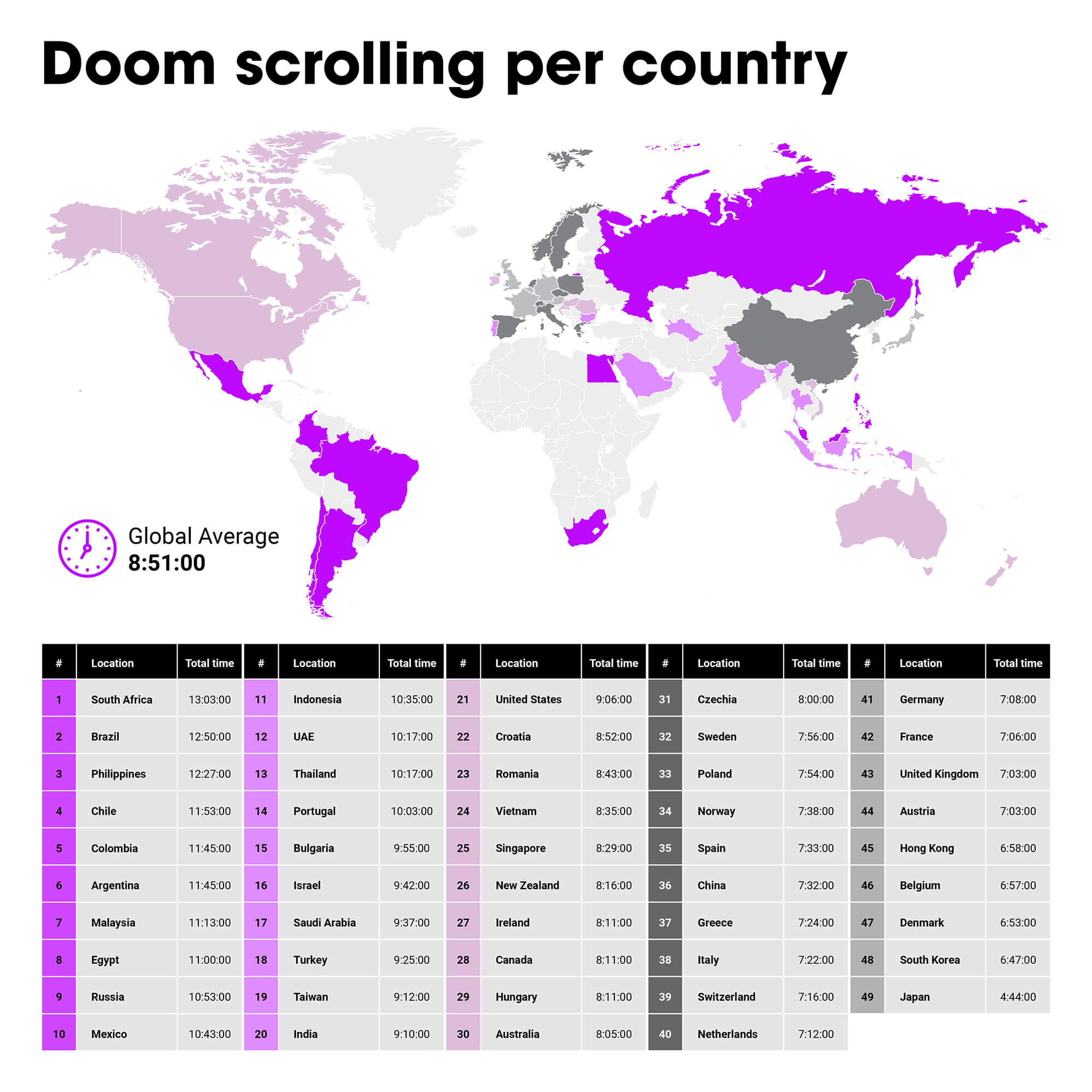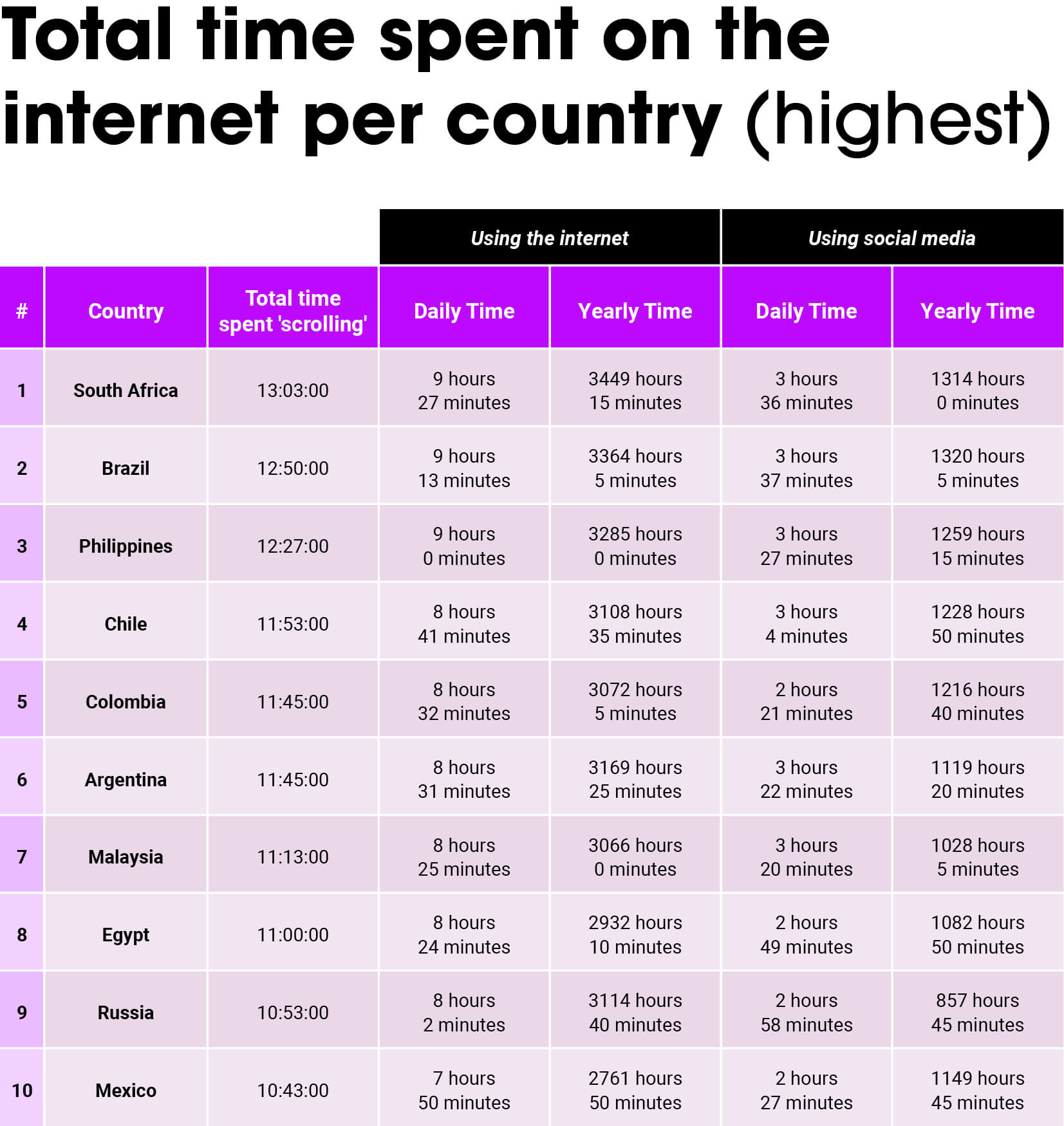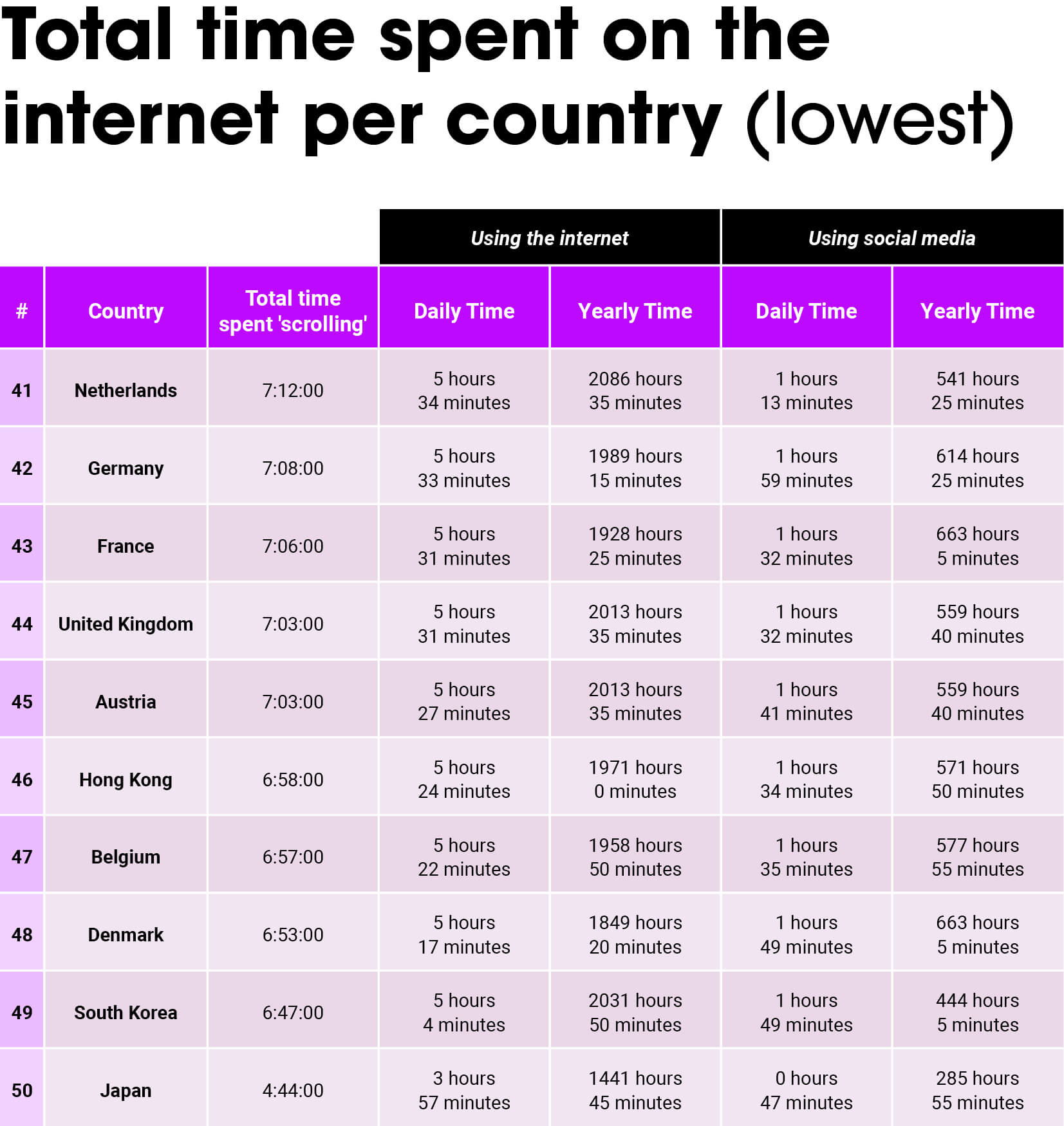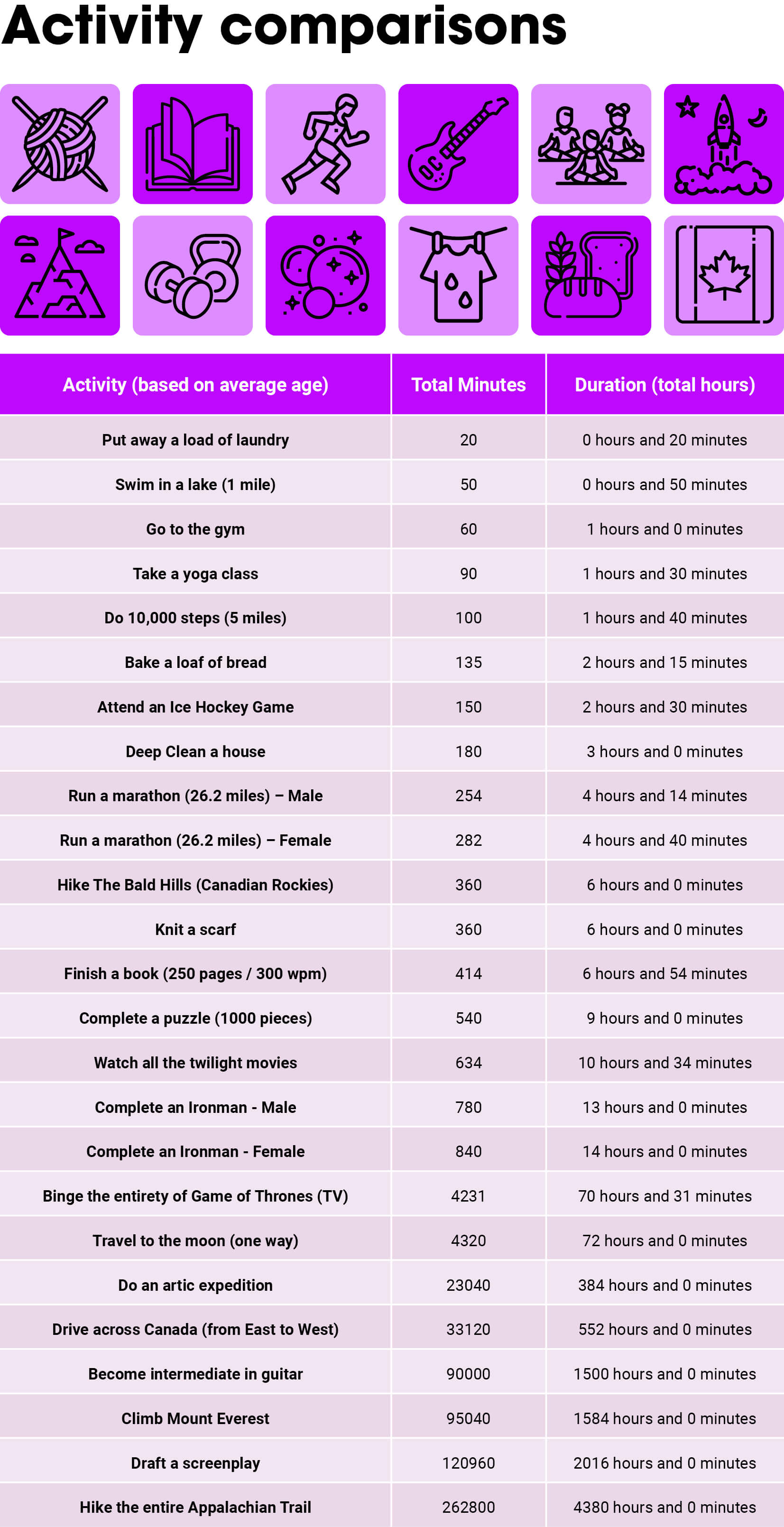The rise of doom scrolling - which countries are swiping the most?
As technology and social media grow their share in everyday life, people around the globe are getting sucked into their phone screens, laptop screens, and any other device you can think of.
This obsession has become so concerning that TikTok, a social media app which profits off users’ screen time, has started reminding users to stop scrolling and go for a break.
This is because any activity done in front of a screen (screen time) is usually spent sitting down using little to no energy, which raises health concerns in the long term. ‘Scroll time’ makes up the largest percent of screen time globally, and refers to the total time spent scrolling through social media apps and the internet specifically.
While a large proportion of screen time happens in the workplace, most of the time spent scrolling through social platforms and the internet happens outside of work in people's free time and is easily avoidable.
Whether you’re at work or home, screen time is an undeniable fate, but some countries are better for limiting aimless ‘doom scroll time’ than others.
To find out how different countries spend their time online, experts at Jackpot City have delved into the digital footprint of internet users globally.
Canada's scrolling habits
The attention-sucking power of our screens causes Canadians to lose 8 hours and 11 minutes a day to the internet and social media on average. This equates to 2.38 days a week and 123.76 days a year - longer than it would take you to climb Mount Everest (66 days).
Of this, they spend just under 2 hours a day on social media. But this time spent scrolling builds up quickly, to just over a full day every 2 weeks (1.1 days), 2.4 days a month, or 28.6 days a year - longer than it would take you to road trip across Canada from East to West (23 days).
It’s easy to feel connected to people when you're on social media, but in reality, there’s a lot more you could do with the time that you build up ‘doom scrolling’ to no avail on these platforms. As 58.6% of Canadians use social media to keep in touch with friends and family, the 28.6 days lost online could be spent visiting them in person instead.

The social platforms taking up most of Canada’s time
In Canada’s doom-scrolling era, TikTok takes up most of people’s time - approximately 1.6 days a month (38 hours and 47 minutes), or 19.4 days a year.
YouTube is the second largest doom-scrolling vice for Canadians, where they lose 19 hours and 4 minutes a month.
Facebook scrollers follow, wasting an impressive 16 hours and 42 minutes on the platform per month - without taking into account any time spent on the Facebook messenger platform, where users spend another 5 hours and 27 minutes a month.
Snapchat and Instagram make up the top five most used social media platforms in Canada, where users spend 12 hours 49 minutes and 12 hours 33 minutes a month respectively.
One of the least-used social media platforms in Canada is LinkedIn, with users spending less than an hour there per month (51 minutes).

Why Canada uses social media
Of this time spent on social media, 58.2% of Canadians use the platforms primarily to stay connected with friends and family. This reflects a growing dependence on digital communication globally, especially as a result of remote work and global events which continue to keep people physically distant.
The ability to communicate with anyone in the world is a huge advantage for businesses too, with 16.3% of Canadians using social media for work-related networking or research.
Filling spare time was the second largest driver for scroll time in the country, with 43.3% of residents using social media as a go-to entertainment source.
Social media is also becoming a more popular way to get news, with 31% of Canadians using these platforms to read news stories and keep up with global affairs.
Canadians also use social media for inspiration (26%) and finding content (29.4%), whether that’s for lifestyle or shopping ideas, this shows the growing power of influencers on these platforms.
Smaller but notable percentages of Canadians use social media to post about their lives (19.2%), join like-minded communities (19.8%), and to avoid FOMO - fear of missing out (17.4%).
Lifetime spend scrolling
As of April 2022, 87% of teenagers in Canada aged between 12 and 17 years old were reported to own a smartphone.
With average life expectancy in Canada at 81.6 years in 2021, if Canadians were to pick up the country’s average scrolling habits (8 hours and 11 minutes a day) by the age of 17, they would lose 22 years to scrolling in their lifetime (7,965 days).
While Canadians could be doing more with the time they lose scrolling, their habits actually fall below the global average by 4 minutes a day. Just by scrolling on social media and the internet, people across the world lose an average of 8 hours and 15 minutes a day, 11.2 days a month, and 134.6 days a year.
Doom scrolling by country

Countries with the highest scroll time
In 2024, global social media and internet usage showed significant regional differences, with countries like South Africa, Brazil, and the Philippines leading the way in terms of time spent online.
South Africa topped the list for doom scrolling, where residents wasted 13 hours and 3 minutes a day on social media and the internet combined, or 198.5 days a year. Of this time, over 54 days a year (1,314 hours) were spent scrolling through social media.
Brazil followed close behind, with residents each spending 12 hours and 50 minutes a day scrolling on average, just over 195 days a year. Annually, social media alone counted for 55 days (1,320 hours) of this time - the most out of any country.
The Philippines comes in third place, seeing its residents spend 12 hours and 20 minutes a day scrolling in total, or 189 days a year (4,544 hours) - with just over 52 days a year (1,259 hours) dedicated to social media.
The Latin American countries of Chile and Columbia also showed some of the highest levels of internet and social media usage globally, with just over 180 days (4,337 hours) and 178 days (4,288 hours) lost scrolling each year respectively.

Countries with the lowest scroll time
Japan falls on the other end of the scale, with the lowest scroll time out of any country at 4 hours and 44 minutes a day.
Japan’s low scroll time could be partly due to the country having the second oldest population in the world, with 29% of residents over the age of 65 in 2023. At this age, the internet penetration rate stands at just 36.4%, compared to 98% among those aged between 13 and 49, bringing down the national average internet usage.
Surprisingly, South Korea had the second lowest scroll time, spending an average of 6 hours and 47 minutes online per day - despite being recognised as a global innovation hub. Both Japan and South Korea have a reputation for long working hours and working from home is not common, leaving less opportunity to build up scroll time.
Denmark and Belgium also reported low daily scrolling times of 6 hours and 53 minutes and 6 hours and 57 minutes, respectively. Both countries have a strong focus on work-life balance and well-being, supported by policies that encourage less screen time and more face-to-face interaction.
Hong Kong had the fifth lowest scroll time overall, at 6 hours and 58 minutes a day. This figure may have dropped as a result of warnings to Hong Kong students last year, who were told to look after their eyesight after the number of young people needing glasses rose by 4% post-pandemic due to screen time.

Sleepy countries

The average sleep time in Canada is 7 hours and 11 minutes each night. Comparing this to the country's scroll time, Canadians could fit a full night's sleep into the hours they spend on the internet and social media each day, which stands at 8 hours and 11 minutes on average.
As with scroll time, sleep patterns across the world also showed significant regional differences in 2024.
Bulgaria stands out as the sleepiest country of all, with residents resting for an impressive 12 hours and 28 minutes a night on average; The country’s scroll time is also substantial, at 9 hours and 55 minutes a day.
Assuming Bulgarian residents spend half their average ‘sleep time’ resting after midnight (6 hours and 14 minutes), work a standard 8-hour day, and also spend 9 hours and 55 minutes a day scrolling on average, this leaves just one single minute spare a day for other activities.
This stands in contrast to Japan, where residents have the lowest average sleep duration (5 hours and 22 minutes) and scroll time (4 hours and 44 minutes). This vast difference may reflect cultural attitudes toward work, relaxation, and rest.
While the standard work week in Japan is 40 hours, overtime is common, with Japanese ‘salarymen’ working white-collar jobs well-known for prioritizing work over everything else in life, leaving little time to sleep or scroll in their free time.
Doom scrolling time alternatives
Overall, the data revealed that people across the world lose just over 134 days a year online (3,230 hours and 15 minutes).

In this time lost doom-scrolling each year, you could have: drafted a screenplay (12 weeks), road-tripped across the entirety of Canada from East to West (23 days), done an Arctic Expedition (16 days), traveled to the moon and back (6 days), binged the entirety of the Game of Thrones series (just under 3 days), and binged all of the Twilight movies (10 hours and 34 minutes) - and still have over two days spare.
In the average time that Canadians spend scrolling each day - 8 hours and 11 minutes - they could hike The Bald Hills in the Canadian Rockies (6 hours) and still have time to fit in another 10,000 steps after (1 hour and 40 minutes).
While scrolling in your spare time is a personal choice, there are many other things you could achieve in the time that you’re lost in the trance of technology - which would better both your physical and mental well-being.
And as workplace wellbeing becomes a growing focus for companies and employees alike, employers should also aim to reduce sedentary screen time in the office. Introducing mandatory lunch breaks away from your desk, encouraging in-person communication in the office rather than email, and providing standing or walking desks are all actions that can be made to address this at work.
If you’re concerned about your at-home scroll time, you can set limit reminders to get up and take a break, or remove the culprit social media apps entirely, make plans where you can leave your phone at home, and prioritize in-person phone-free time with friends and family.
ENDS
Methodology
To gather information on the screen time of internet users globally, JackpotCity analyzed 2024 global digital behavior data from DataReportal. The analysis focused on the average time spent using the Internet and social media across 49 countries.
This data was compared against the average daily schedule for each country. This included average sleep duration, sourced from World Population Review, and standard working hours, which were primarily obtained from official government websites. Where official data was unavailable, working hours were sourced from BoundlessHQ.
Data on the time required to complete various activities was sourced from trusted websites on Google and is available upon request. All information is accurate as of September 2024.

